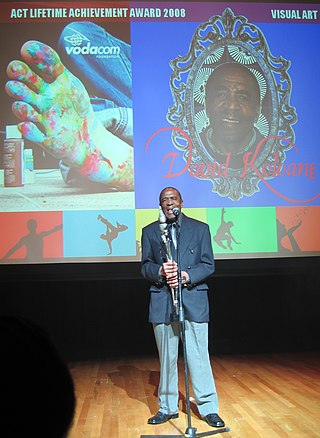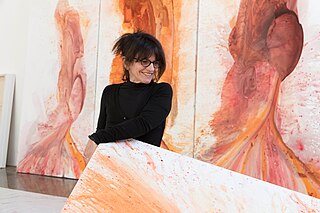David Goldblatt HonFRPS was a South African photographer noted for his portrayal of South Africa during the apartheid period. After apartheid's end, he concentrated more on the country's landscapes. Goldblatt's body of work was distinct from that of other anti-apartheid artists in that he photographed issues that went beyond the violent events of apartheid and reflected the conditions that led up to them. His forms of protest have a subtlety that traditional documentary photographs may lack; Goldblatt said, "[M]y dispassion was an attitude in which I tried to avoid easy judgments.... This resulted in a photography that appeared to be disengaged and apolitical, but which was in fact the opposite." Goldblatt also wrote journal articles and books on aesthetics, architecture, and structural analysis.
Jeremy Wafer is a South African sculptor and printmaker.
Omar Badsha is a South African documentary photographer, artist, political and trade union activist and historian. He is a self-taught artist. He has exhibited his art in South Africa and internationally. In 2015, he won the Arts & Culture Trust (ACT) Lifetime Achievement Award for Visual Art. In 2017, he received an honorary doctorate Doctor of Philosophy (DPhil), for his groundbreaking work in the field of documentary photography in South Africa. He was also awarded a Presidential honor The Order of Ikhamanga in Silver for "His commitment to the preservation of our country’s history through ground-breaking and well-balanced research, and collection of profiles and events of the struggle for liberation"
Jürgen Schadeberg was a German-born South African photographer and artist. He photographed key moments in South African history, including iconic photographs such as Nelson Mandela at Robben Island prison. He also lived, worked and taught in London and Spain, and photographed in many African countries.
Ernest Levi Tsoloane Cole was a South African photographer. In the early 1960s, he started to freelance for clients such as Drum magazine, the Rand Daily Mail, and the Sunday Express. This made him South Africa's first black freelance photographer.
Patrick Bond is Distinguished Professor at the University of Johannesburg Department of Sociology, where he directs the Centre for Social Change. From 2020 to 2021 he was professor at the University of the Western Cape School of Government and from 2015 to 2019, distinguished professor of political economy at the University of the Witwatersrand Wits School of Governance. Before that, from 2004, he was senior professor at the University of KwaZulu-Natal, where he directed the Centre for Civil Society. His research interests include political economy, environment, social policy, and geopolitics.

Zanele Muholi is a South African artist and visual activist working in photography, video, and installation. Muholi's work focuses on race, gender and sexuality with a body of work that dates back to the early 2000s, documenting and celebrating the lives of South Africa's Black lesbian, gay, transgender, and intersex communities. Muholi is non-binary and uses they/them pronouns, explaining that "I'm just human".
Richard Scott is a South African artist, residing in Cape Town and well known for the phrase Naive meets Pop art to describe his unique take on Art. He is very well known for his art both in South Africa and internationally.

David Nthubu Koloane was a South African artist. In his drawings, paintings and collages he explored questions about political injustice and human rights. Koloane is considered to have been "an influential artist and writer of the apartheid years" in South Africa.
Graeme Williams is a South African photographer known for both his photojournalism during the transition to democracy in South Africa and his documentary projects post-apartheid.
George Hallett was a South African photographer known for images of South African exiles. His body of work captures much of the country's turbulent history through Apartheid and into the young democracy.

Gille de Vlieg is a photographer and anti-apartheid activist. She was born in England and moved to South Africa with her mother when she was 3 years old. During apartheid she was a member of both the Black Sash and one of the few women members of the Afrapix photography collective. Her images have been published in newspapers, magazines and books nationally and internationally. Unlike many of her counterparts, de Vlieg received little public acclaim for her work up until recently. About her work, she says, "I wanted to make a contribution to an alternative view of South Africa, a view not seen on the South African TV screen then." Her images cover the following topics: land removals, rural lifestyle, township lifestyle, gender lifestyle, United Democratic Front (UDF), anti-harassment campaign, police violence, protests against death penalty, funerals, Black Sash, protests against incorporation into Bophuthatswana; Release Mandela Campaign, End Conscription Campaign (ECC), conscientious objectors, African National Congress (ANC) Welcome Home Rally, Day of the Vow (Geloftedag), street children, and homeless people.
Eric Miller is a professional photographer based in South Africa. Miller was born in Cape Town but spent his childhood in Johannesburg. After studying psychology and working in the corporate world for several years, Miller was driven by the injustices of apartheid to use his hobby, photography, to document opposition to apartheid by becoming a full-time photographer.
Nontsikelelo "Lolo" Veleko is a South African photographer most noted for her depiction of black identity, urbanisation and fashion in post-apartheid South Africa.
Afrapix was a collective agency of amateur and professional photographers who opposed Apartheid in South Africa and documented South Africa in the 1980s. The group was established in 1982 and dissolved itself in 1991.
Gisèle Wulfsohn was a South African photographer. Wulfsohn was a newspaper, magazine, and freelance photographer specialising on portrait, education, health and gender issues. She was known for documenting various HIV/AIDS awareness campaigns. She died in 2011 from lung cancer.

Penny Siopis is a South African artist from Cape Town. She was born in Vryburg in the North West province from Greek parents who had moved after inheriting a bakery from Siopis maternal grandfather. Siopis studied Fine Arts at Rhodes University in Makhanda, completing her master's degree in 1976, after which she pursued postgraduate studies at Portsmouth Polytechnic in the United Kingdom. She taught Fine Arts at the Technikon Natal in Durban from 1980 to 1983. In 1984 she took up a lectureship at the University of the Witwatersrand in Johannesburg. During this time she was also visiting research fellow at the University of Leeds (1992–93) and visiting professor in fine arts at Umeå University in Sweden (2000) as part of an interinstitutional exchange. With an honorary doctorate from Rhodes University, Makhanda – Siopis is currently honorary professor at Michaelis School of Fine Art, University of Cape Town.

Jo Ractliffe is a South African photographer and teacher working in both Cape Town, where she was born, and Johannesburg, South Africa. She is considered among the most influential South African "social photographers."
Sabelo Mlangeni is a South African photographer living and working in Johannesburg, South Africa. His work is held in the collections of the Art Institute of Chicago, the San Francisco Museum of Modern Art, and the Walther Collection.
Bongiwe or Bongi Dhlomo-Mautloa, is a Zulu South African printmaker, arts administrator and activist.



